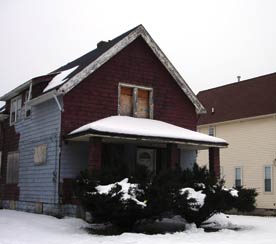
Neighborhood Progress Inc.
“What we now have taking place in Cleveland is an ‘REO Race,’” wrote Frank Ford in our Fall/Winter 2009 issue, describing a “tsunami” of neglected, vacant, unmaintained properties affecting his city’s neighborhoods. “Can financial institutions ‘unload’ or ‘dump’ their liability before the local municipal code enforcement officials catch up with them? In their race to dump property, the banks are making no effort to screen the buyers.”
Both the irresponsible investors banks were selling to and the banks themselves were ignoring properties they owned, allowing them to decay past the point of no return. It got so bad that the Cleveland Municipal Housing Court (see p. 26) levied millions of dollars of fines on REO investors and servicers for failing to show for court hearings.
Now, in at least a few cases, properties with no real market value are heading in a different direction: In June, Wells Fargo donated a handful of vacant properties to the Cuyahoga Land Bank, which was in formation when Ford was writing in 2009. Crucially, Wells also contributed up to $7,500 per property to cover the cost of demolition ($3,500 per property in NSP2 target areas). Before long, Bank of America was on board with the same price model.
Russ Cross, Midwest regional servicing director for Wells Fargo Home Mortgage said in a statement made at the time of their announcement that Wells has donated 26 properties and $127,000, “and we will look at additional properties that we can contribute.”
It’s clear why such a move would be in the self-interest of the lenders: they off-load properties where they won’t recover costs anyway in a way that reduces possible legal exposure (and fines) and mitigates the increasingly negative PR they are getting. But that’s OK: it’s also in the best interests of Cleveland’s neighborhoods.
Of course, at this volume the donations make a very small dent in a much bigger vacant and abandoned properties problem. The work of creating incentives for owners of vacant properties to do the right thing, through codes and the courts and the streets, clearly needs to continue.




Comments